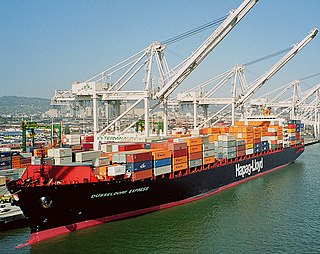
Hapag-Lloyd AG is a German international shipping and container transportation company, the 4th biggest in the world. It was formed in 1970 through a merger of Hamburg-American Line (HAPAG) and Norddeutscher Lloyd.
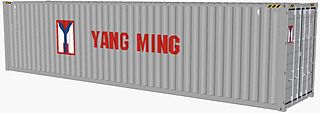
Yang Ming Marine Transport Corporation is a Taiwanese container shipping company based in Keelung, Taiwan.

The Hamburg-Amerikanische Packetfahrt-Actien-Gesellschaft (HAPAG), known in English as the Hamburg America Line, was a transatlantic shipping enterprise established in Hamburg, in 1847. Among those involved in its development were prominent citizens such as Albert Ballin, Adolph Godeffroy, Ferdinand Laeisz, Carl Woermann, August Bolten, and others, and its main financial backers were Berenberg Bank and H. J. Merck & Co. It soon developed into the largest German, and at times the world's largest, shipping company, serving the market created by German immigration to the United States and later, immigration from Eastern Europe. On 1 September 1970, after 123 years of independent existence, HAPAG merged with the Bremen-based North German Lloyd to form Hapag-Lloyd AG.

On 26 March 1997, the 300-ft merchant vessel MV Cita pierced its hull when running aground on rocks off the south coast of the Isles of Scilly in gale-force winds en route from Southampton to Belfast. The incident happened just after 3 am when the German-owned, Antiguan-registered 3,000 tonne vessel hit Newfoundland Point, St Mary's.

Colombo Express was one of the largest container ships in the world. When launched in 2005, she was claimed by her owner to be the world's largest container ship, a title she held until Emma Mærsk was launched in 2006.

Yantian Express is a Hapag-Lloyd Hamburg Express-class container ship, delivered in 2002. She was constructed by Hyundai Heavy Industries in Ulsan, South Korea, a measures 320 by 43 m, and delivered under the name Berlin Express but soon renamed Shanghai Express. Her capacity is 7,510 20ft containers and she carries this load at 22.5 knots.
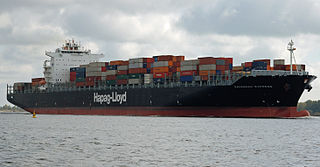
Savannah Express, is a container ship owned by the Norddeutsche Reederei H. Schuldt company out of Hamburg, Germany. She was completed in 2005. The ship is capable of transporting up to 8401 TEUs at any one time, making her at that time one of the largest container ships in the world. The deadweight tonnage (DWT) is 107,000 metric tons and the maximum speed of this ship is 25 knots. The ship is 332 metres (1,089 ft) long and has a beam of 43.2 metres (142 ft). The engines are capable of outputting 68,520 kilowatts of power.
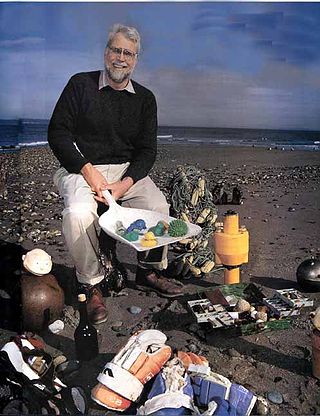
Curtis Charles Ebbesmeyer is an American oceanographer based in Seattle, Washington. In retirement, he has studied the movement of flotsam to track ocean currents.

Friendly Floatees are plastic bath toys marketed by The First Years and made famous by the work of Curtis Ebbesmeyer, an oceanographer who models ocean currents on the basis of flotsam movements. Ebbesmeyer studied the movements of a consignment of 28,800 Friendly Floatees—yellow ducks, red beavers, blue turtles, and green frogs—that were washed into the Pacific Ocean in 1992. Some of the toys landed along Pacific Ocean shores, such as Hawaii. Others traveled over 27,000 kilometres (17,000 mi), floating over the site where the Titanic sank, and spent years frozen in Arctic ice before reaching the U.S. Eastern Seaboard as well as British and Irish shores, fifteen years later, in 2007.
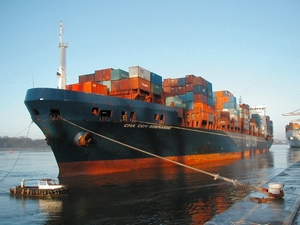
MSC Napoli was a United Kingdom-flagged container ship that developed a hull breach due to rough seas and slamming in the English Channel on 18 January 2007. She was deliberately run aground at Lyme Bay to avoid an environmental disaster and broken up by salvors.

CSAV is a Chilean shipping company that is currently the largest company of its type in Latin America and also one of the oldest ones, having been founded in 1872.

The RMS Mülheim was a German cargo ship that was built in Romania and launched in May 1999. It was wrecked on 22 March 2003 at Land's End, United Kingdom.

The Rena oil spill occurred off the coast of Tauranga, New Zealand in October 2011. The spill was caused by the grounding of MV Rena on the Astrolabe Reef. The Rena was a container ship and cargo vessel owned by the Greek shipping company Costamare Inc., through one of its subsidiary companies Daina Shipping. The spill has been described as New Zealand's worst maritime environmental disaster.

Kyoto Express is a container ship of the Colombo Express class of ships owned and operated by Hapag-Lloyd AG. Registered in Monrovia, Liberia, the vessel has been in operation since 2005.

Chicago Express is a container ship for the Hapag Lloyd Container Line, and is one of eight in the Colombo Express class.
The collision between MV Testbank and MV Seadaniel took place in the Mississippi River – Gulf Outlet Canal (MRGO) on July 22, 1980 when the outbound 485-foot (148 m) German container ship Testbank and inbound 580-foot (180 m) Panamanian-flagged bulk carrier Seadaniel collided near mile 41 of the canal.

MOL Comfort was a 2008-built Bahamian-flagged post-Panamax container ship chartered by Mitsui O.S.K. Lines. The vessel was launched in 2008 as APL Russia and sailed under that name until 2012, when the ship was renamed to MOL Comfort. On 17 June 2013, she broke in two about 200 nautical miles off the coast of Yemen. The aft section sank on 27 June and the bow section, after having been destroyed by fire, on 11 July.

Hong Kong Express is a fully cellular container ship of the Hamburg Express Class owned and operated by the German shipping company Hapag-Lloyd Container Linie.
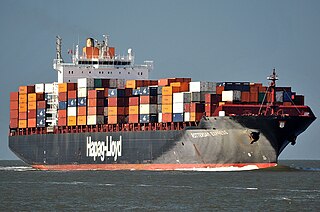
MV Rotterdam Express is a container ship built in 2000 and in the Hapag-Lloyd fleet as of 2021.



















